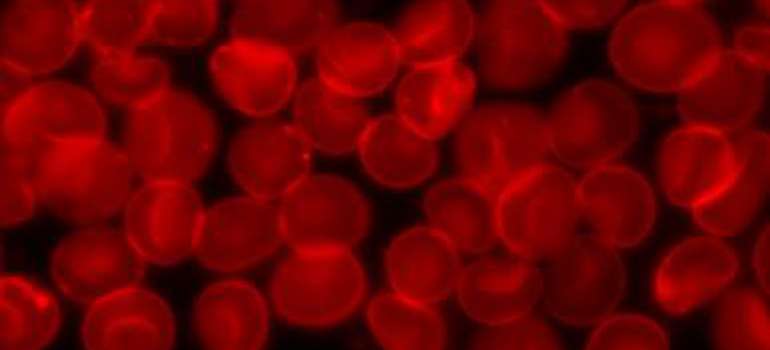3-D imaging reveals secrets of immune cells' agility

Newly developed microscopy techniques have allowed UC San Francisco researchers to observe white blood cells in action in unprecedented detail. Videos the scientists have created using these advanced microscopes are revealing the secrets of how these cells—called neutrophils—are able to move with greater speed and agility than almost any other cell in the body.
Neutrophils are the immune system's first line of defense against infection. If you fall and scrape your knee, they race to the site of injury to hunt down potentially dangerous bacteria and other invaders. In pursuit of their prey, neutrophils can move up to 1000 times faster than most cells in your body and can twist and turn with surprising nimbleness.
Researchers have known for more than half a century that neutrophils are capable of rapid and decisive attacks on bacteria—one 1950s-era laboratory film of a neutrophil pursuing and eating a Staphylococcus aureus bacterium has become a classic familiar to most cell biologists. But until recently, little has been known about how these cells are able to move so quickly and acrobatically through the confusing jungle of the body's tissues to sniff out and destroy invasive cells.
Dyche Mullins, PhD—a professor of cellular and molecular pharmacology at UCSF and the senior author of the new paper, published online in eLife on September 26, 2017—has long been interested in how amoebas and similar fast-crawling cells that are part of our own bodies can move with such nimbleness through their environments.
"We've learned a lot about human cells move from amoebas," Mullins said. "Amoebas running around in the dirt hunting yeast are very similar to immune cells crawling around our bodies hunting bacteria. We want to understand the fundamental cellular mechanisms of motion that have been conserved across evolution—those that are true of an amoeba as well as human cells."
In recent years, Mullins has been working with 2014 Nobel laureate Eric Betzig, PhD, and researcher Bi-Chang Chen, PhD, of the Howard Hughes Medical Institute's Janelia Research Campus in Virginia—both co-authors on the new paper—to adapt a new biological imaging tool called lattice light sheet microscopy, developed by Betzig, to observe living cells in 3-D at ultra-high resolution.
One of the key breakthroughs in revealing the full potential of this technique was the realization by the authors of the new paper that a biological visualization tool developed at UCSF called Chimera could make it possible to process and visualize the vast amounts of data produced by lattice light sheet microscopes. Co-authors Thomas Goddard, PhD, of the Chimera project and Graham Johnson, PhD, a former QB3 fellow at UCSF now at the Allen Institute for Cell Science in Seattle, helped the team render reams of 3-D data, revealing the detailed and complex shapes neutrophils make while crawling.
"It was unprecedented to be able to see living cells in 3-D in such detail—like putting on glasses for the first time," Mullins said. "I immediately wanted to look at neutrophils. That was our first question: what do these amoeboid cells look like when they're on the move?"
Like other amoeboid cells, neutrophils typically appear amorphous—able to change shape at will. They constantly extend and retract exploratory feelers called pseudopods, which sniff for chemical signals of bacteria, and they can stretch themselves flat or rear up like snakes and fold back on themselves like contortionists. But when Mullins and his team studied active neutrophils under the lattice light sheet microscope, they quickly realized that all of neutrophils' shape-shifting is built on a simple underlying mechanism: fin-like sheets that grow out from the cell body and sweep through the environment, sometimes merging and combining with other sheets to form more complex rosette-like structures.
"We've found that neutrophils are not really amorphous. Everything that looked more complex, when we observed at higher resolution, turned out to be made of other flat sheets," Mullins said.
Curious whether these sheets were necessary for neutrophils' ability to crawl through tissue, the researchers applied a drug that prevented the cells from forming such projections. They found that when the neutrophils were unable to produce their sheet-like projections, it slowed them down by about 40 percent, and severely reduced their ability to turn, causing them to crawl along mostly in straight lines.
"We suspect that these cells lose the ability to turn because they use these feelers to probe their environment for new paths, which lets them switch which direction they're moving. Obviously, they don't have eyes—they can't 'see' anything they can't touch," Mullins said.
These new findings are part of a revolution in understanding the details of cell movement—both the cells that make up our own bodies and free-living microorganisms. Recent work by the Mullins lab, for instance, has found that the chytrid fungus that has been decimating populations of frogs and other amphibians around the world is capable of transforming itself into a fast-moving amoeba-like form, which may explain its ability to jump rapidly from one animal to another.
Better understanding how cells move may lead to better approaches to preventing diseases caused by single-celled critters and also to an enriched understanding of how to give our own immune cells the ability to outmaneuver them.
More information: Lillian K Fritz-Laylin et al. Actin-based protrusions of migrating neutrophils are intrinsically lamellar and facilitate direction changes, eLife (2017). DOI: 10.7554/eLife.26990

















